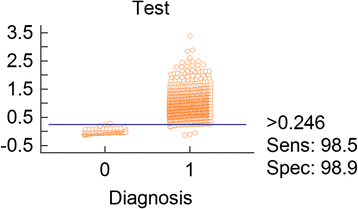Seroprevalence of bovine theileriosis in northern China
- PMID: 27863521
- PMCID: PMC5116182
- DOI: 10.1186/s13071-016-1882-x
Seroprevalence of bovine theileriosis in northern China
Abstract
Background: Bovine theileriosis is a common disease transmitted by ticks, and can cause loss of beef and dairy cattle worldwide. Here, an indirect enzyme-linked immunosorbent assay (iELISA) based on Theileria luwenshuni surface protein (TlSP) was developed and used to carry out a seroepidemiological survey of bovine theileriosis in northern China.
Methods: We used the BugBuster Ni-NTA His•Bind Purification Kit to purify recombinant TlSP (rTlSP), which was subsequently analyzed by Western Blotting to evaluate cross-reactivity with other pathogen-positive sera. The iELISA method based on rTlSP was successfully developed. Sera from 2005 blood samples were tested with the rTlSP-iELISA method, and blood smears from these samples were observed by microscopy.
Results: The specificity of iELISA was 98.9%, the sensitivity was 98.5%, and the cut-off was selected as 24.6%. Western Blot analysis of rTlSP confirmed that there were cross-reactions with Theileria luwenshuni, Theileria uilenbergi, Theileria ovis, Theileria annulata, Theileria orientalis and Theileria sinensis. The epidemiological survey showed that the highest positive rate of bovine theileriosis was 98.3%, the lowest rate was 84.1%, and the average positive rate was 95.4% by iELISA. With microscopy, the highest positive rate was 38.9%, the lowest rate was 5.1%, and the relative average positive rate was 13.7%.
Conclusions: An rTlSP-iELISA was developed to detect circulating antibodies against bovine Theileria in northern China. This is the first report on the seroprevalence of bovine theileriosis in northern China, and it also provides seroepidemiological data on bovine theileriosis in China.
Keywords: ELISA; Microscopy; Prevalence; Theileriosis.
Figures



Similar articles
-
An indirect ELISA for detection of Theileria spp. antibodies using a recombinant protein (rTlSP) from Theileria luwenshuni.Exp Parasitol. 2016 Jul;166:89-93. doi: 10.1016/j.exppara.2016.03.027. Epub 2016 Apr 2. Exp Parasitol. 2016. PMID: 27048941
-
Evaluating an indirect rMPSP enzyme-linked immunosorbent assay for the detection of bovine Theileria infection in China.Parasitol Res. 2017 Feb;116(2):667-676. doi: 10.1007/s00436-016-5332-7. Epub 2016 Dec 10. Parasitol Res. 2017. PMID: 27942962
-
Validation of a recombinant protein indirect ELISA for the detection of specific antibodies against Theileria uilenbergi and Theileria luwenshuni in small ruminants.Vet Parasitol. 2014 Aug 29;204(3-4):139-45. doi: 10.1016/j.vetpar.2014.05.010. Epub 2014 May 17. Vet Parasitol. 2014. PMID: 24912957
-
From molecule to diagnostic tool: Theileria annulata surface protein TaSP.Parasitol Res. 2007 Sep;101 Suppl 2:S217-23. doi: 10.1007/s00436-007-0685-6. Parasitol Res. 2007. PMID: 17823831 Review.
-
Control of tropical theileriosis with attenuated schizont vaccine in China.Vaccine. 2008 Dec 19;26 Suppl 6:G11-3. doi: 10.1016/j.vaccine.2008.09.069. Vaccine. 2008. PMID: 19178886 Review.
Cited by
-
Multiplex PCR for rapid differential diagnosis of co-prevalent species of Theileria (Theileria annulata and Theileria orientalis) in cattle.Parasitol Res. 2023 May;122(5):1189-1197. doi: 10.1007/s00436-023-07819-1. Epub 2023 Mar 10. Parasitol Res. 2023. PMID: 36897381
-
Molecular detection and genetic diversity of Theileria orientalis in cattle in China.Parasitol Res. 2018 Dec;117(12):3689-3694. doi: 10.1007/s00436-018-6023-3. Epub 2018 Jul 28. Parasitol Res. 2018. PMID: 30056555
-
Seroprevalence and risk factors of tropical theileriosis in smallholder asymptomatic large ruminants in Egypt.Front Vet Sci. 2022 Oct 11;9:1004378. doi: 10.3389/fvets.2022.1004378. eCollection 2022. Front Vet Sci. 2022. PMID: 36304407 Free PMC article.
-
Genomic Profiling for Piroplasms in Feeding Ixodid Ticks in the Eastern Cape, South Africa.Pathogens. 2020 Dec 18;9(12):1061. doi: 10.3390/pathogens9121061. Pathogens. 2020. PMID: 33353073 Free PMC article.
References
Publication types
MeSH terms
Substances
LinkOut - more resources
Full Text Sources
Other Literature Sources

